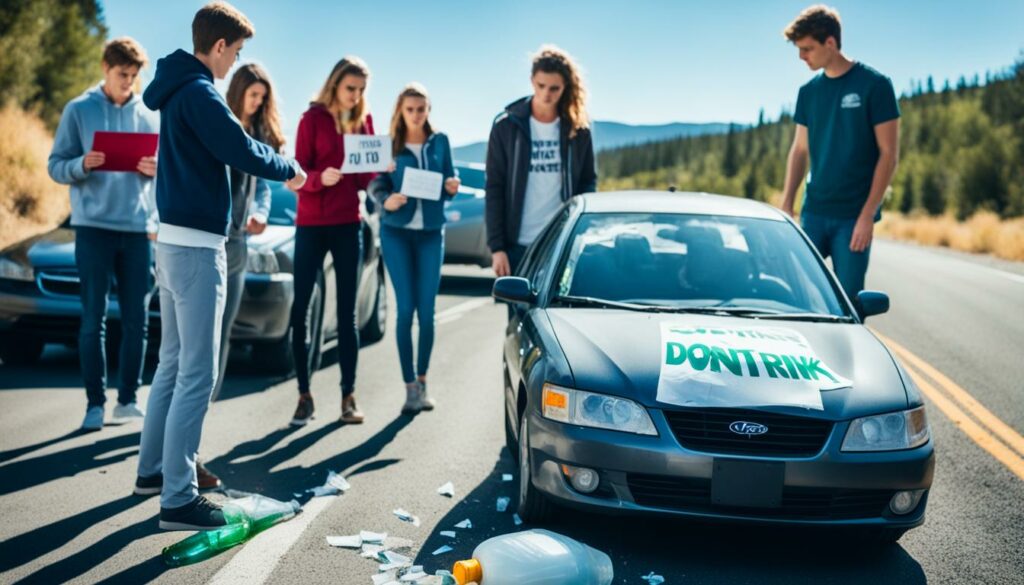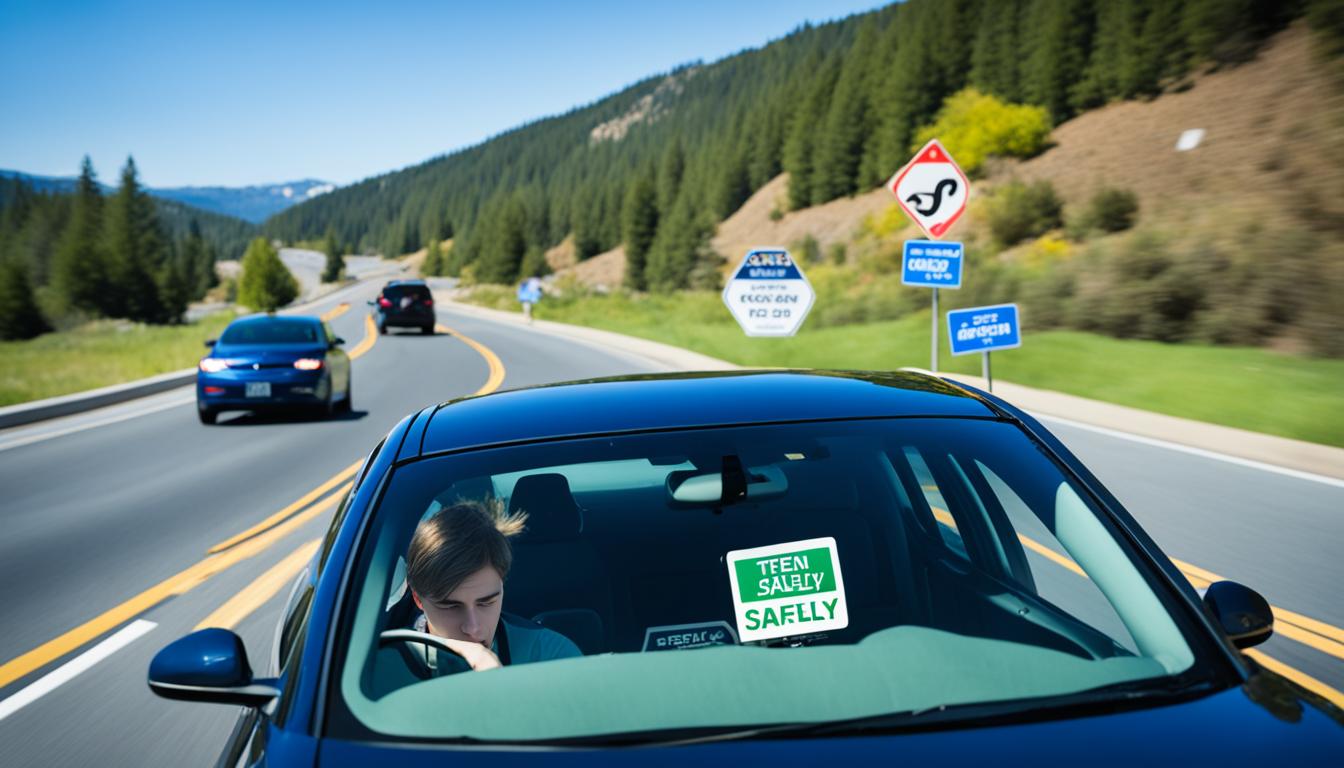Teenage Driving Risks: Why It’s Considered Dangerous
Welcome to our article on teenage driving risks and the importance of promoting safe driving habits for teenagers. Teenagers often face a higher risk of car accidents due to their immaturity, lack of skills, and limited driving experience.
Statistics show that teenage drivers are more prone to making critical errors on the road, leading to severe consequences. Factors such as speeding, distractions, impaired driving, and the influence of passengers can significantly increase the likelihood of accidents.
Preventing teenage driving accidents is of utmost importance, as such incidents can have long-lasting effects on the lives of young drivers and their families. By educating teenagers about these risks and promoting safe driving practices, we can help them become responsible and cautious drivers.
In this article, we will explore the various factors that contribute to teenage driving hazards and discuss practical tips to ensure the safety of teenage drivers and those around them. Let’s delve into the details and learn more about this critical issue.
Key Takeaways:
- Teenage drivers have a higher rate of fatal crashes due to their immaturity and lack of experience.
- Risk factors include speeding, distractions, impaired driving, and the influence of passengers.
- Preventing teenage driving accidents requires educating teenagers about the risks and promoting safe driving practices.
- Parents can play a crucial role in promoting safe driving habits and setting ground rules for their teens.
- Implementing graduated driver licensing systems can help reduce high-risk driving situations for teen drivers.
The Impact of Distracted Driving on Teenagers

Inexperience and susceptibility to distractions make teenage drivers more prone to distracted driving. Research shows that talking or texting on the phone while driving significantly increases the risk of crashing. Other distractions include eating, applying makeup, and having passengers in the vehicle. Parents can educate their teens about the dangers of distracted driving and enforce rules that prohibit phone use and other distractions while driving.
Distracted driving is a significant concern for teenage drivers. Phone use while driving, especially texting, poses a significant risk, diverting attention from the road ahead. According to National Highway Traffic Safety Administration (NHTSA), distracted driving claimed 3,142 lives in 2019 alone.
Teenagers’ developing brains and limited driving experience compound the dangers of distracted driving. Their ability to multitask and make split-second decisions is not yet fully developed, making it even more critical to minimize distractions behind the wheel.
Educating teens about the risks and consequences of distracted driving is crucial in preventing distracted driving accidents. Parents can have an open and honest conversation with their teens, explaining the potential dangers and emphasizing the responsibility that comes with driving. Promote safe habits and lead by example by refraining from using phones or engaging in other distractions while driving.
| Potential distractions for teenage drivers | Percentage of crashes involving distractions |
|---|---|
| Phone use (texting, talking) | 14% |
| Eating and drinking | 7% |
| Passenger interaction | 15% |
| Applying makeup or grooming | 1% |
Table: Distractions and their involvement in teenage driving accidents
The Role of Passengers in Teen Car Accidents

When it comes to teenage drivers, the presence of passengers can significantly impact their driving behavior and increase the risks on the road. Teenagers often find joy and excitement in driving with their friends, but this can also lead to dangerous situations and fatal crashes.
Research has shown that having multiple passengers in a teenage driver’s car increases the likelihood of engaging in risky behaviors such as speeding, reckless driving, and distracted driving. This is because the presence of friends can act as a source of peer pressure, encouraging the driver to take unnecessary risks to impress or entertain their peers.
To address this issue, many states have implemented passenger restrictions for teen drivers. These restrictions typically limit the number of passengers a teenage driver can have in the car, especially during the early stages of their driving experience. By reducing the number of passengers, distractions inside the vehicle can be minimized, allowing the driver to focus better on the road and make safer decisions.
“Having multiple passengers in the car can increase the risk of crashes for newly licensed teen drivers by as much as 44%, as compared to driving alone.”
– National Highway Traffic Safety Administration (NHTSA)
Parents also play a crucial role in preventing accidents caused by passengers. They can enforce additional rules that limit the number of passengers their teenage drivers can have, especially during the first few months of driving. By clearly communicating the importance of responsible driving and the potential consequences of risky behaviors, parents can help their teens understand the gravity of their choices.
Moreover, parents should remind their teenagers to prioritize safety and focus on the road, even when there are passengers in the car. Encourage open dialogue about the potential dangers of driving with friends, including the potential for distractions and peer pressure. By promoting responsible driving habits, parents can help reduce the risks associated with teenage drivers and passengers.
Preventing Distractions from Passengers
To further reduce distractions from passengers, parents and teen drivers can follow these guidelines:
- Establish clear rules and expectations regarding passenger behavior and interactions while in the car.
- Encourage passengers to refrain from engaging in distracting activities, such as playing loud music, engaging in rowdy behavior, or using their phones excessively.
- Create a comfortable and calm environment inside the vehicle to minimize disruptions and foster a safer driving experience.
- Remind passengers to support the driver’s focus on the road and avoid engaging in conversations or activities that may divert the driver’s attention.
By implementing these measures, both parents and teenage drivers can work together to reduce distractions caused by passengers and create a safer driving environment.
| Passenger Restrictions for Teen Drivers | Number of Passengers Allowed |
|---|---|
| State A | One unrelated passenger under 18 years old for the first six months of driving. |
| State B | No passengers under 18 years old for the first twelve months of driving. |
| State C | No passengers under 21 years old for the first six months of driving. |
| State D | No restrictions on passengers for teen drivers. |
The Dangers of Speeding Among Teen Drivers

Speeding is a critical safety issue for teen drivers, posing significant risks on the road. Studies have shown that as teens gain confidence behind the wheel, their speeding behavior tends to increase, making it crucial to address this hazardous habit.
Driving over the speed limit amplifies the chances of accidents for teenage drivers. Speeding reduces the reaction time to potential hazards, increases the distance needed to stop the vehicle, and decreases the control over the car. This combination can have dire consequences, especially for inexperienced drivers who may struggle to handle unexpected situations.
Teens should be aware of their speed, especially in challenging road conditions or during inclement weather. Encourage them to adjust their driving to ensure they maintain a safe speed limit. It’s essential for parents to discuss the dangers of speeding with their teenage drivers and emphasize the importance of adhering to speed limits and road regulations.
“Speeding doesn’t save time; it costs lives. It’s essential for teens to understand that obeying speed limits is a fundamental part of responsible driving, ensuring their safety and the safety of others on the road.” – [Insert Expert Name]
Parents can set a positive example by demonstrating responsible driving behavior and obeying speed limits themselves. This reinforces the message and encourages teens to understand the gravity of speeding-related accidents. By promoting awareness and actively discouraging speeding, we can work towards preventing speeding-related accidents and creating safer roads for everyone.
Preventing Drunk Driving and Drug Use Among Teenagers

It is crucial to educate teenagers about the dangers of underage drinking and driving under the influence. Engaging in these activities can have severe consequences and lead to alcohol-related crashes with devastating outcomes.
One important fact to emphasize is that drinking alcohol under the age of 21 is illegal in all states. Teenagers need to understand the legal implications of underage drinking and the potential personal consequences that can result from their actions.
However, preventing alcohol-related accidents involves more than just enforcing the law. Parents have a crucial role to play in educating their teens about the risks of drinking and driving. By fostering open and honest conversations, parents can guide their children towards making responsible choices.
Discussing the effects of drugs on driving is equally important. Many teenagers may not fully comprehend the impairing effects that drugs can have on their ability to operate a vehicle safely. Through education, parents can help teens recognize the potential dangers and make informed decisions about avoiding drug use before driving.
Teen Driving Safety Tips:
- Always designate a sober driver or use alternative transportation options like ride-sharing services or public transportation.
- Encourage peer accountability by promoting a culture of responsible decision-making and discouraging friends from getting behind the wheel while under the influence.
- Set clear boundaries and consequences regarding alcohol and drug use.
- Lead by example by modeling responsible behaviors and never driving under the influence.
“Educating teenagers about the risks of drunk driving and drug use behind the wheel is essential for their safety. By providing them with the knowledge and support they need, we can help shape responsible and conscientious drivers.”
By prioritizing education and communication, parents can help prevent alcohol-related crashes and protect their teens from the dire consequences of impaired driving. Taking an active role in promoting safe driving practices is vital for creating a safer environment on the roads for everyone.
The Importance of Seat Belt Use for Teen Drivers
Seat belt use among teenage drivers is a critical safety measure that can significantly reduce the risk of injuries and deaths in car accidents. Research indicates that seat belts can reduce serious crash-related injuries and deaths by about half. It is crucial to enforce seat belt laws for young drivers to promote safety on the roads.
Primary enforcement of seat belt laws allows police officers to ticket drivers or passengers for not wearing a seat belt. This strict enforcement serves as a deterrent and encourages seat belt usage among teenagers. By adhering to seat belt laws, young drivers can protect themselves and their passengers from severe injuries in the event of a collision.
Parents play a vital role in reinforcing the importance of seat belt use among their teen drivers. By setting a good example and consistently wearing their own seat belts, parents can instill safe habits and attitudes in their children. Additionally, it is essential for parents to familiarize themselves with their state’s seat belt laws to ensure compliance and avoid potential penalties.
Seat belt use is a simple yet effective way to reduce injuries and deaths among teenage drivers. By emphasizing its significance and enforcing seat belt laws, we can create a safer driving environment for young individuals. Remember, buckling up can make all the difference in preventing tragic accidents and protecting lives.
| Benefits of Seat Belt Use for Teen Drivers | Statistics |
|---|---|
| Reduces the risk of fatal injuries | Seat belts can lower the risk of death by 45% for teen drivers. |
| Minimizes the severity of injuries | Seat belts can reduce the risk of moderate to critical injuries by 50%. |
| Keeps occupants in place during a crash | Seat belts prevent ejection from the vehicle, reducing the risk of further injuries or fatalities. |
| Reduces the likelihood of collision-related injuries | Seat belts keep occupants firmly in their seats, preventing them from colliding with the vehicle’s interior or other passengers. |
The Benefits of Graduated Driver Licensing Systems
Graduated driver licensing (GDL) systems have been implemented in all U.S. states and the District of Columbia to promote safe driving practices among teen drivers. These systems aim to reduce teen crashes and deaths by allowing new drivers to gain experience and skills under lower-risk conditions.
Research has consistently shown that GDL systems are effective in reducing the incidence of teen crashes and fatalities. By implementing GDL programs, states have witnessed a significant decline in accidents involving young drivers.
GDL systems typically consist of three stages:
- Learner’s Permit: During this initial stage, new drivers are required to complete a certain number of hours of supervised driving practice. This allows them to develop basic driving skills and gain familiarity with traffic laws and regulations.
- Intermediate/Provisional License: Once the learner’s permit requirements are fulfilled, drivers advance to the intermediate/provisional license stage. This stage comes with certain restrictions, such as limits on nighttime driving and the number of passengers allowed in the vehicle. These restrictions help reduce high-risk situations, such as driving late at night or with distracting friends in the car.
- Full Licensure: After successfully completing the provisional license stage, drivers are granted full licensure. At this point, they have demonstrated competency and responsibility on the road.
Parents play a crucial role in ensuring their teens’ adherence to the restrictions and guidelines set by GDL systems. By providing guidance, support, and monitoring, parents can help their teens become safe and responsible drivers.
Table: The Stages of Graduated Driver Licensing
| Stage | Description |
|---|---|
| Learner’s Permit | Allows new drivers to gain experience through supervised driving practice |
| Intermediate/Provisional License | Comes with restrictions on nighttime driving and passenger limits |
| Full Licensure | Granted to drivers who have successfully completed the previous stages |
By promoting safe driving practices through GDL systems, we can reduce the number of teen crashes and deaths on our roads. It is crucial for parents to support their teens’ participation in GDL programs and emphasize the importance of following the restrictions and guidelines at each stage. Together, we can create a safer driving environment for our young drivers.
The Risks of Speeding for Teen Drivers
Speeding is a significant risk factor for teen drivers, contributing to a high number of fatal crashes. Research has shown that speeding increases the likelihood of accidents and decreases the amount of time a driver has to react to potential hazards on the road. Teens, who are already at a higher risk due to their inexperience and impulsiveness, must be aware of the dangers of excessive speed.
When teenagers exceed the speed limit, they put themselves and others at risk. The consequences of speeding-related crashes can be severe, including injuries, loss of life, legal ramifications, and increased insurance rates. It is essential for teen drivers to understand that the thrill of speed is not worth jeopardizing their safety and the safety of those around them.
In order to reduce speeding behavior among teens, parents play a crucial role. By monitoring their teen’s driving habits and having open conversations about the risks and consequences of speeding, parents can help instill responsible driving behaviors. Leading by example is also vital; when teens see their parents obeying speed limits and exercising caution on the road, they are more likely to follow suit.
Impaired Driving: Alcohol and Drugs Among Teenagers
Driving under the influence of alcohol or drugs is extremely dangerous, especially for teenagers. It is crucial to educate teens about the severe consequences of impaired driving, both legally and personally. Underage drinking is illegal, and driving under the influence can lead to tragic outcomes, including injuries and fatalities.
Parents play a crucial role in reinforcing the message and discussing the risks associated with alcohol and drug use while driving. By setting clear expectations and consequences for driving under the influence, parents can instill responsible behavior in their teens.
Teenagers need to understand that impaired driving not only puts their lives at risk but also endangers the lives of others on the road. It is essential to emphasize the potential legal repercussions, such as license suspension, fines, and even criminal charges. More importantly, the physical and emotional consequences resulting from impaired driving can have a lasting impact on their lives and the lives of innocent victims they may harm.
Educating teens about the risks and dangers of impaired driving is vital to prevent alcohol and drug-related crashes. Engaging in open and honest conversations about the potential consequences can help them make informed decisions and resist peer pressure.
The Consequences of Driving Under the Influence
Driving under the influence can have both immediate and long-term consequences for teenagers. Some of the potential consequences include:
- Legal repercussions: Teens caught driving under the influence may face legal consequences, such as fines, license suspension, probation, mandatory community service, or even imprisonment, depending on the severity of the offense.
- Increased insurance premiums: A DUI conviction can lead to significantly higher insurance premiums, making it more expensive for teenagers to drive legally.
- Personal and emotional impact: Impaired driving accidents can result in severe injuries, disabilities, or even death. Teenagers may have to live with the guilt and emotional trauma of causing harm to themselves or others.
- Negative impact on future opportunities: A DUI conviction can affect a teenager’s educational and career prospects. It may limit their chances of gaining admission to college, securing scholarships, or obtaining certain job opportunities.
Educating teens about these consequences is essential to prevent them from making life-altering mistakes. By emphasizing the potential long-term impact of impaired driving, parents can help their teens understand the gravity of the situation and why it is crucial to make responsible choices.
Preventing Alcohol and Drug-Related Crashes
Preventing alcohol and drug-related crashes among teenagers requires a multifaceted approach that involves education, communication, and setting clear boundaries. Here are some strategies parents can use to prevent impaired driving:
- Open and honest conversations: Engage in regular conversations with teenagers about the risks associated with alcohol and drug use while driving. Use real-life examples and news stories to illustrate the potential consequences and emphasize the importance of making responsible decisions.
- Lead by example: Be a role model by exhibiting responsible behavior when it comes to alcohol and drugs. Avoid driving under the influence and emphasize the importance of designated drivers or alternative transportation options.
- Set clear expectations and consequences: Establish clear rules and consequences regarding alcohol and drug use while driving. Ensure that your teen understands the repercussions they will face if they choose to disregard these rules.
- Encourage alternative options: Encourage teenagers to plan ahead and use alternative transportation options if they are impaired. This can include ridesharing services, public transportation, or relying on a designated driver.
- Monitor and communicate: Maintain open lines of communication with your teen and stay involved in their activities. Know where they are going, who they will be with, and establish a system of check-ins to ensure their safety.
Promoting Seat Belt Use Among Teen Drivers
Ensuring that teen drivers wear seat belts is critical for their safety on the road. Seat belts significantly reduce the risk of serious injuries and fatalities in car crashes. To promote seat belt use among teen drivers, parents can take proactive steps and set a positive example. By emphasizing the importance of buckling up every time they get into the car, parents can instill responsible habits in their teen drivers.
It is also essential for parents to familiarize themselves with seat belt laws and enforcement in their state. Understanding the specific regulations for young drivers can help parents reinforce the importance of seat belt use and educate their teens about the consequences of non-compliance.
“Wearing a seat belt is not only the law, it’s a life-saving habit,” says Dr. Sarah Johnson, a renowned expert in teen driver safety. “By making seat belt use a non-negotiable expectation, parents can help protect their teen drivers and create a culture of safety on the road.”
To encourage seat belt use among teen drivers, parents can:
- Have open and ongoing conversations about seat belt safety
- Lead by example and always wear their seat belt when driving
- Remind their teens to buckle up before every trip
- Set clear consequences for not wearing a seat belt
- Encourage their teens to remind friends and passengers to buckle up
By prioritizing seat belt use, parents can help increase seat belt usage rates among teen drivers. This simple habit can make a significant difference in reducing the severity of injuries or even saving lives in the event of a car accident.
The Effectiveness of Graduated Driver Licensing Systems
Research has consistently demonstrated the effectiveness of Graduated Driver Licensing (GDL) systems in reducing teen crashes and injuries. These systems, implemented in all U.S. states and the District of Columbia, provide a structured approach to help new drivers gain experience and skills under lower-risk conditions.
GDL systems typically consist of three stages: learner’s permit, intermediate/provisional license, and full licensure. Each stage introduces progressively higher levels of driving privileges and responsibilities. This gradual approach allows teen drivers to acquire essential skills and mature as they progress through the stages.
One of the key features of GDL systems is the longer practice period during the learner’s permit stage. This extended practice time allows teens to gain more experience behind the wheel under the guidance of a licensed adult. By providing ample time to develop basic driving skills, GDL systems help reduce the risks associated with inexperienced drivers.
Furthermore, GDL systems limit high-risk driving conditions for teen drivers. This includes restrictions on nighttime driving, passenger limits, and prohibitions on using electronic devices while behind the wheel. These restrictions recognize that certain situations can pose significant risks for inexperienced drivers and aim to mitigate those risks.
Parental involvement is another crucial component of GDL systems. Parents play an important role in supervising their teen’s driving practice, setting rules and expectations, and reinforcing safe driving behaviors. Research has shown that active parental involvement in GDL programs leads to better compliance and safer driving habits among teen drivers.
To make GDL systems even more effective, it is essential for states to continually evaluate and update their laws and practices. Best practices for GDL include regular review of current restrictions, implementing stricter penalties for non-compliance, and incorporating evidence-based strategies to address specific areas of concern, such as distracted driving or impaired driving.
By supporting their teens’ participation in GDL systems and advocating for stronger GDL laws and practices, parents can contribute to reducing teen crashes and injuries on the road.
Evidence of GDL System Effectiveness
| Impact Area | Evidence |
|---|---|
| Crash reduction | Multiple studies have shown a significant reduction in teen crashes in states with GDL systems compared to states without such systems. |
| Injury prevention | GDL systems have been associated with a decrease in the severity of injuries sustained by teen drivers involved in crashes. |
| Fatality reduction | States with comprehensive GDL systems have experienced a decline in the number of fatalities involving teen drivers. |
| Long-term impact | Research has shown that the benefits of GDL systems extend beyond the initial licensing stages, reducing crash rates as teens transition to full licensure. |
Evidence supports the effectiveness of GDL systems in reducing teen crashes and injuries, highlighting the importance of these programs in promoting safer roads for all drivers.
Conclusion
In conclusion, teenage driving poses significant risks due to inexperience, distractions, speeding, impaired driving, and passengers. Fortunately, parents can play a crucial role in promoting safe driving habits among their teens. By setting rules, enforcing restrictions, and modeling responsible behavior, parents can help reduce the chances of their teenagers being involved in accidents.
Additionally, the implementation of graduated driver licensing systems and the importance of seat belt use are effective measures in minimizing teen crashes and fatalities. Graduated driver licensing systems provide young drivers with the necessary skills and experience while limiting high-risk driving situations. Seat belts, on the other hand, have been proven to reduce injuries and deaths in car crashes by approximately 50%.
It’s also vital to educate teenagers about the risks and consequences of unsafe driving practices. By creating awareness and discussing the potential dangers of distractions, speeding, impaired driving, and the influence of passengers, we can work towards reducing teenage driving accidents and making our roads safer for everyone.
FAQ
Why is teenage driving considered dangerous?
Teenage driving is considered dangerous due to factors such as inexperience, distractions, speeding, impaired driving, and passengers. These factors increase the risk of accidents and fatalities for teen drivers.
What are some of the risks associated with teenage driving?
Some risks associated with teenage driving include inexperienced driving skills, distractions like cell phone use, speeding, impaired driving, and the presence of passengers in the car. These factors contribute to a higher rate of accidents among teen drivers.
How can we prevent teenage driving accidents?
Preventing teenage driving accidents involves promoting safe driving habits among teenagers. This can be done through education, enforcing rules and restrictions, setting a good example as parents, and supporting the implementation of graduated driver licensing systems.
What are some safety tips for teenage drivers?
Safety tips for teenage drivers include avoiding distractions like texting or talking on the phone while driving, obeying speed limits, wearing seat belts, not driving under the influence of alcohol or drugs, and following the restrictions and guidelines of the graduated driver licensing system.
How can parents promote safe driving habits among their teen drivers?
Parents can promote safe driving habits among their teen drivers by setting rules and restrictions, communicating the risks and consequences of unsafe driving practices, modeling responsible behavior, and supporting their participation in graduated driver licensing systems.
What role do distractions play in teenage driving accidents?
Distractions significantly contribute to teenage driving accidents. Common distractions include cell phone use, talking to passengers, eating, and applying makeup. Educating teens about the dangers of distracted driving and enforcing rules that prohibit distractions while driving can help prevent accidents.
Why are passengers a risk factor for teen drivers?
Having passengers in the vehicle increases the risk of accidents for teen drivers. Multiple passengers can lead to distractions and risky behaviors. Many states have implemented passenger restrictions for teen drivers to minimize these risks.
What are some effective measures for reducing speeding among teen drivers?
To reduce speeding among teen drivers, it is important to educate them about the risks of speeding and the consequences of speeding-related accidents. Parents can set a good example by obeying speed limits and address speeding behavior with their teen drivers.
How can we prevent drunk driving and drug use among teenagers?
Preventing drunk driving and drug use among teenagers requires educating them about the risks and consequences of impaired driving. It is essential to set clear expectations and consequences for driving under the influence, as well as to discuss responsible decision-making and personal accountability.
Why is seat belt use important for teen drivers?
Seat belt use is essential for teen drivers as it significantly reduces the risk of serious injuries and deaths in crashes. Parents can promote seat belt use by setting the example, discussing the importance of buckling up, and familiarizing themselves with their state’s seat belt laws.
What are graduated driver licensing systems, and how do they promote safe driving?
Graduated driver licensing (GDL) systems provide new drivers with a staged learning process that allows them to gain experience and skills under lower-risk conditions. GDL systems reduce high-risk driving situations for teen drivers and have been shown to effectively reduce crashes and fatalities.
How effective are graduated driver licensing systems in reducing teen crashes?
Research has consistently shown that graduated driver licensing systems are effective in reducing teen crashes and injuries. These systems involve three stages: learner’s permit, intermediate/provisional license, and full licensure. Parents can support their teens’ participation in GDL systems and ensure they adhere to the restrictions and guidelines.
Can you summarize the risks associated with teenage driving?
Teenage driving carries risks due to factors such as inexperience, distractions, speeding, impaired driving, and passengers. However, parents and educational systems can play a significant role in promoting safe driving habits, reducing these risks, and preventing teenage driving accidents.







